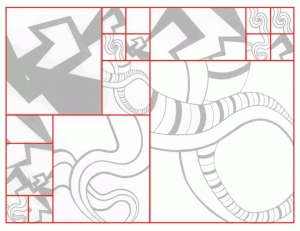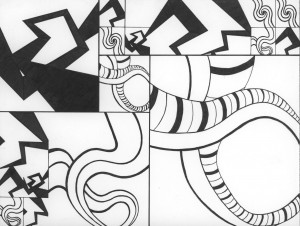Sound Visualizations
Problem: Create black and white compositions using a variety of marks to demonstrate an understanding of visual rhythm, repetition, and pattern. These compositions will attempt to visualize sounds and uncover the relationships between what you hear and what you see.
Materials: Creative Process Book, pencils, inking pens, Bristol Board 9×12″, Bristol Board 14×17”, old newspaper/magazines, scissors, exacto knife, ruler/t-square, glue.
Concepts: Line, Rhythm, Repetition, Variety, Pattern and Texture
Technical Skills: thumbnail sketching, mark-making, draughmanship with ruler/t-square, inking pens, exacto knife and collage.
References: Anita Lillie | Design Meltdown | Wassily Kandinsky & Music | Design in Nature
Phase 1: Discover
Listening
- Listen to your favorite piece of music.
- Imagine what the sounds and patterns you hear look like and consider how they relate to each other.
Writing
- Compose a minimum 2-paragraph description of the sounds you hear.
- Describe them in terms of pattern, line, shape. Consider how some sounds repeat to create rhythm.
- Are some sounds rough or sharp and other smooth and flowing?
- Do any of these observations affect how you understand the meaning of the music or the intention of the composer/songwriter/artist?
Documentation and Feedback
- Create a new blog post called Sound Visualizations: Phase 1.
- Add a link to the piece of music that you listened to via YouTube, SoundCloud, or similar.
- Refine your writing and add it to the post.
- Include the hours that you worked on this part of the project.
- Don’t forget to comment on at least 3 other student’s posts.
Phase 2: Define
Staccato / Legato Pattern Mashup
- Take out a soft pencil #3B and your sketchbook.
Rhythmic Line Test 1: Listen to this song: Another One Bites the Dust and draw a line representing its rhythm across your first sheet of paper. Repeat and refine until you get a variety of interesting lines. How would you describe these lines?
Rhythmic Line Test 2: Listen to this song: Summertime and draw a line representing its rhythm across your second sheet paper.Repeat and refine until you get a variety of interesting lines. How would you describe these lines?
Pattern Squares: Now create at least 12 thumbnails: 6 for Staccato and 6 for Legato. Using your rhythmic line tests as a guide, create 6 pattern squares that represents STACCATO and 6 pattern squares that represents LEGATO. Continue to refine these sketches. Try varying the line weight (thick and thin) and the spacing (tight and wide) between the lines. Let the rhythm of each piece of music dictate the look and feel of your patterns.
Once you have created a total of 6 strong patterns (3 Staccato and 3 Legato) move on to the next step. Refer to class pattern examples for ideas.
Mashup: On 9×11″ Bristol create 1 final inked composition using 1-2 Staccato and 1-2 Legato pattern squares. Even though the composition will be a field of pattern, it should feel unified. You will unite two rhythms (Staccato and Legato), like a DJ mixing parts of different songs. Before you begin working, make a layout and think about how you will arrange your different patterns on the page. How will they relate to each other? Will the pattern squares complement each other or repel each other? What will it sound like?
Some squares should be larger, some should be smaller, all should repeat at least twice.
Consider this layout from a former student, as an example:
Documentation and Feedback
- Create a new blog post called Sound Visualizations: Phase 2.
- Take photos of your finished Inked Pattern Mashup and add it to the post (make sure it is well-lit and in focus.)
- Include the hours that you worked on this part of the project.
- Don’t forget to comment on at least 3 other student’s posts.
Phase 3: Develop
Create a Mashup Animation
PREP in Photoshop:
- Scan your finished Staccato / Legato Pattern Mashup (300dpi, grayscale). Save this hi-res file as FirstInitalLastNameMashupHIRES.psd.
- Open your file in Photoshop and rename it FirstInitalLastNameAnimatedMashup.psd. Make the following adjustments:
- Image size: 72 dpi, constrain proportions
- Color Mode: RBG
- Using the slice tool, slice up each pattern square for use in your animation.
Animate and Add Audio
- Use the free online software Animatron to create a short animation and audio mashup using the two songs with Staccato and Legato rhythms. Use Summertime and Another One Bites the Dust, if you wish. The songs you choose should demonstrate, very clearly, these two rhythms.
- Instructions to be added to the class 10 outline.
Mashup REFERENCES:
- Stayin’ Alive In The Wall (Pink Floyd vs Bee Gees Mashup) by Wax Audio
- “Hahahrawrrahaha” Someone made a song using Jeff Goldblum’s weird laugh from Jurassic Park
- Brian Williams Raps “Rapper’s Delight“
- ‘The Great Gatsby’ Mash-Up Turns Leonardo DiCaprio Into a ‘My Little Pony‘
- A Designer’s Midcentury-Mod Music-Graphics Mashups
- Esoteric mash up
- The Magic of Mashups – Corporate Logos
- 7 Mashups That Will Change The Way You Look At Music Forever
Documentation and Feedback
- Create a new blog post called Sound Visualizations: Phase 3.
- Add a link or embed to your animation and sound mashup
- Include the hours that you worked on this part of the project.
- Don’t forget to comment on at least 3 other student’s posts.
Phase 4: Deliver
Critique
- Bring all parts of this project to class. Take a photo of the work displayed in the classroom.
- Be prepared to present, discuss and analyze your finished work in terms of concept, craft, what you learned, and the design process.
- State the following: your name, what you are presenting (title and design problem), which parts are successful and why, which parts are unsuccessful and why.
- Your peers and the professor will provide feedback. You will have an opportunity to revise your work based on the feedback and improve your grade.
Documentation and Feedback
- Create a new blog post called Sound Visualizations: Phase 4.
- In the post, document your thoughts about this project. Think about what you learned, what you could have done better (planning, material use, craft), and how you will apply what you learned to your next project. Consider and respond to the comments made in class during the critique.
- Include the photo of the work as it is presented during the critique (ie: hanging on the wall).
- Don’t forget to comment on at least 3 other student’s posts.
Print this page 

